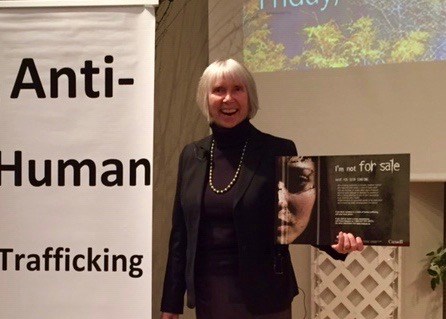A retired teacher will present her views on child sex trafficking to Richmond council on Monday, but a local sex worker support agency warns that non-experts actually do more harm than good.
Cathy Peters’ presentation — scheduled as a delegation at council — includes talk about “red flags” to identify human trafficking, including symptoms like poor mental health, poor physical health, lack of control or lack of knowledge of whereabouts.
Peters’ report also states that “buying and selling children for sex is one of the fastest growing crimes in Canada,” but she doesn’t cite any statistics on this.
She told the Richmond News that Canada doesn’t have any statistics on child sex trafficking, but the U.S. does keep numbers and one can “presume” the same trends exist in Canada.
Peters said Statistics Canada’s numbers on human trafficking are “small,” but the “trends are large” and should include missing women’s statistics as well.
However, Alison Clancey with SWAN — a non-profit that works with migrant sex workers in Richmond and other communities — said that, while her organization is concerned about human trafficking and works to prevent it, many anti-trafficking efforts are “ineffective” and some “even create vulnerability to exploitation and trafficking.”
Statistics Canada reported that there were a total of 340 human-trafficking cases reported to police across Canada in 2016 — this was up from 50 in 2009.
Clancey calls Peters’ written report to Richmond council “incoherent” and says it confuses child sex trafficking, prostitution and human trafficking and contains inconsistent statistics (Peters writes that the average age of entry into prostitution is 12 to 14 but later states the “common age” is 14 to 16).
In her biography, Peters says she is a “former inner city teacher.” She said she’s in touch with all municipal councils across B.C., with members of Parliament and members of the legislative assembly.
She told the News she knows “too much” and doesn’t want to overwhelm the public with her information.
When asked why she does this advocacy work, Peters said she was sparked to do it while teaching near King George Highway, where she saw prostitution, and also while working with vulnerable youth in high schools.
“I have a heart for the vulnerable, for the rejected, the throwaways, the runaways,” Peters said.
Peters claims organizations like Swan and Pivot Legal Society want prostitution to “grow and flourish” because they receive funding for their work.
Clancey said she respects Peters’ concern for child and youth victims of trafficking, but she suggests she contact her organization and Richmond RCMP to learn that child sex trafficking has never been an issue at body rub studios in Richmond.
“Confusing the two issues only harms the women working at these establishments who deserve labour rights and protections,” Clancey said.
“Unfortunately, Mrs. Peters' promotion of a moral panic about child sex trafficking impedes this dialogue from happening.”
In 2014, The Atlantic magazine, a U.S.-based publication, looked for the source of the much-cited statistic that the average age of entry into prostitution is between 12 and 14 and found it was most likely a 2001 study by Richard Estes and Neil Weiner, based on 288 surveys returned from organizations dealing with abused and exploited children (1,130 surveys were sent out — the return rate was 25.5 per cent).
The Atlantic article, written by Chris Hall, points out the number is a description of their sample, not of sex workers in general.



